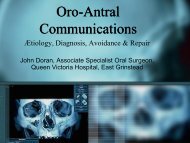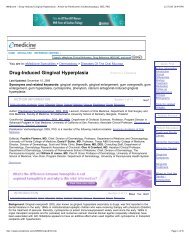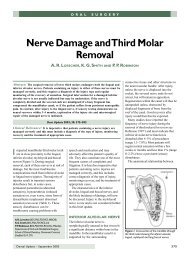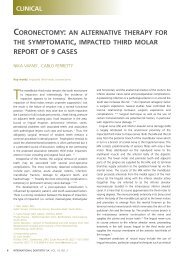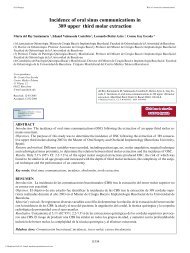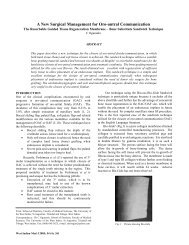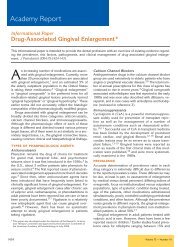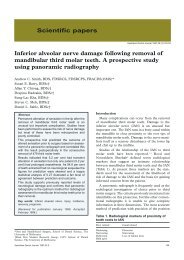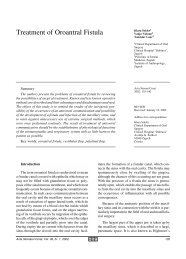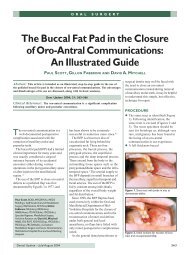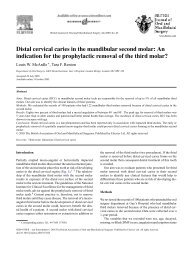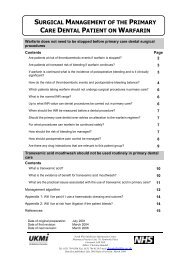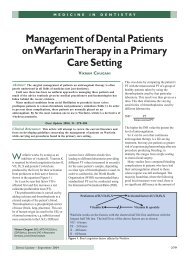Oral Surg Oral Med Oral Pathol Oral Radiol Endod 2004 - Surgical ...
Oral Surg Oral Med Oral Pathol Oral Radiol Endod 2004 - Surgical ...
Oral Surg Oral Med Oral Pathol Oral Radiol Endod 2004 - Surgical ...
You also want an ePaper? Increase the reach of your titles
YUMPU automatically turns print PDFs into web optimized ePapers that Google loves.
ORAL SURGERY ORAL MEDICINE ORAL PATHOLOGY<br />
Volume 97, Number 1<br />
Table VII. Summary of oral care in patients with xerostomia<br />
<strong>Oral</strong> hygiene<br />
Plaque control, oral hygiene instruction, dietary advice,<br />
chlorhexidine mouthwash or fluoride mouthwash daily<br />
(0.05%) to minimize the risk of caries.<br />
Dentures<br />
Should fit well. Implant-retained. Provide instructions on denture<br />
hygiene.<br />
Antifungals<br />
Nystatin pastilles, amphotericin lozenges, miconazole gel<br />
Topical saliva substitutes<br />
Sugar-free gum and candies; oral moisturizers<br />
Systemic therapies<br />
Pilocarpine, cevimeline, and others<br />
Table VIII. Some topical therapies for xerostomia<br />
Sugar-free gum, candies, and liquids 96,97<br />
Lubricating gels, mouthwashes, lozenges, and toothpaste 99-103<br />
Salivary stimulant pastilles 104<br />
Mucin spray 105<br />
Humidifiers 107<br />
Saliva substitute placed in intraoral device 108<br />
Table IX. Systemic therapies for long-standing xerostomia<br />
Therapy<br />
Etiology<br />
Likely to be of benefit<br />
Pilocarpine<br />
Bethanechol<br />
Cevimeline<br />
Interferon <br />
Carbacholine<br />
Bromhexine<br />
Corticosteroids<br />
Hydroxychloroquine<br />
Vitamin supplementation<br />
Acupuncture<br />
Electrostimulation<br />
Evening primrose oil<br />
Unlikely to be of benefit<br />
Azathioprine<br />
Cyclosporine<br />
Methotrexate<br />
SS, Sjögren’s syndrome; , limited data.<br />
Porter, Scully, and Hegarty 35<br />
Head and neck radiation<br />
SS<br />
Chronic graft-versus-host disease<br />
Drug-induced xerostomia<br />
Drug-induced xerostomia<br />
SS<br />
SS<br />
Head and neck radiation<br />
SS<br />
SS<br />
SS<br />
SS<br />
SS<br />
SS<br />
SS<br />
SS<br />
SS<br />
SS<br />
cused on the development of systemic and sicca<br />
symptom questionnaires, and, in Europe, a prospective<br />
evaluation of systemic activity and damage measures<br />
is planned.<br />
ORAL CARE OF LONG-STANDING<br />
XEROSTOMIA<br />
Until recently, the management of long-standing xerostomia<br />
principally consisted of the avoidance of factors<br />
that might cause or aggravate dry mouth, the application<br />
of salivary substitutes, and the prevention of<br />
the associated oral complications. 94 However, local<br />
treatments have not always proved effective. The principal<br />
aspects of the management of long-standing xerostomia<br />
are summarized in Table VII. The different<br />
local and systemic methods for the management of<br />
xerostomia are discussed later.<br />
Topical agents<br />
Traditionally, treatment of dry mouth has focused on<br />
palliative measures with salivary substitutes, but because<br />
these are removed from the mouth during swallowing,<br />
the duration of their effect is short and they also<br />
lack the protective roles of saliva (Table VIII). 95 Saliva<br />
substitutes function in improving lubrication and hydration<br />
of oral tissues and maintaining oral health and<br />
function.<br />
Sugar-free gum or sugar-free candies may help to<br />
increase salivary output, but they may be inconvenient<br />
and affect patients’ compliance. 95 Frequent ingestion<br />
of sugar-free liquids may help. 93 A saliva<br />
substitute with a remineralizing effect on dentin and<br />
enamel and long-lasting relief of the oral symptoms<br />
of dry mouth is preferable. 97 Lubricating agents in<br />
the form of gels, mouthwashes, lozenges, 98 and<br />
toothpastes 99 have been used, with varying results, to<br />
relieve the symptoms of xerostomia. 100 The qualities<br />
of such lubricating agents that increase patients’<br />
acceptance and continued use of the agent include<br />
lubrication, taste, duration of action, the delivery<br />
system, severity of xerostomia, and cost. 101 Some<br />
available proprietary preparations include Luborant<br />
(Antigen, UK), Saliva Orthana (AS Pharma, Sweden),<br />
Salivace, and <strong>Oral</strong> Balance (Anglian, UK),<br />
which have been approved for dry mouth associated<br />
with radiation or SS. 102 Some are unsuitable for<br />
dentate patients because they cause the demineralization<br />
of teeth.<br />
Salivary stimulant pastilles (Salivix, Provalis, UK)<br />
appear to be a useful adjuvant therapy for patients with<br />
dry mouth receiving oxybutynin chloride for detrusor<br />
instability, in that they allow higher doses of oxybutynin<br />
to be tolerated. 103<br />
In a recent study, a mucin spray was found to be<br />
useful against xerostomia in those who had undergone<br />
irradiation, with elderly patients deriving particular<br />
benefit from its use. 104 The results of one<br />
recent study of a topical oral moisturizer indicated<br />
significant subjective and objective improvements in



